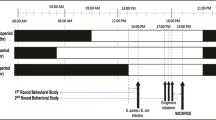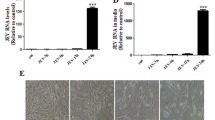Summary
We examined the effect of the pineal neurohormone melatonin (MLT) on protection from viral encephalitis. The antiviral activity of MLT was evaluated in normal mice inoculated with Semliki Forest virus (SFV) and in stressed mice injected with the attenuated non-invasive West Nile virus (WN-25). Administration of MLT (s.c.) daily from 3 days before through 10 days after virus inoculation reduced viremia and significantly postponed the onset of disease and death by 7 to 10 days. Moreover, MLT injection reduced mortality of SFV (10 PFU) inoculated mice from 100% to 44%. In mice inoculated with high dose of SFV (100 PFU), MLT postponed death and reduced mortality by 20%. In all of the surviving mice anti-SFV antibodies were detected 22 days after virus inoculation. Infection of mice stressed by either isolation or dexamethasone injection with WN-25 induced mortality of 75% and 50% respectively, which was reduced by MLT administration to 31% and 25%, respectively. The efficiency of MLT in protecting from lethal viral infections warrants further investigations on its mechanisms of action.
Similar content being viewed by others
References
Ader R (ed) (1981) Psychoneuroimmunology. Academic Press, New York
Ben-Nathan D, Lustig S, Feuerstein G (1989) The influence of cold or isolation stress on neuroinvasiveness and virulence of an attenuated variant of West Nile virus. Arch Virol 109: 1–10
Ben-Nathan D, Feuerstein G (1990) The influence of cold or isolation stress on resistance of mice to West Nile virus encephalitis. Experientia 46: 285–290
Ben-Nathan D, Lustig S, Kobiler D, Danenberg HD, Lupu E, Feuerstein G (1992) Dehydroepiandrosterone (DHEA) protects mice inoculated with West Nile virus and exposed to cold stress. J Med Virol 38: 159–166
Ben-Nathan D, Kobiler D, Feuerstein G, Lustig S (1992) Anti-stress effect of dehydroepinadrosterone (DHEA) on mice inoculated with attenuated arboviruses. Progr Neuro Endocrin Immunol 5: 229–234
Ben-Nathan D, Lachmi B, Lustig S, Feuerstein G (1991) Protection of dehydroepiandrosterone (DHEA) in mice infected with viral encephalitis. Arch Virol 120: 263–271
Blalock JE (1987) Virus induced increase in plasma corticosterone. Science 238: 1424–1425
Bradish CJ, Allner K, Maber HB (1971) The virulence of original and derived strains of Semliki Forest virus for mice, guinea pigs and rabbits. J Gen Virol 12: 141–160
Bradish CJ, Allner K (1972) The early responses of mice of respiratory or intraperitoneal infection by defined virulent and avirulent strains of Semliki Forest virus. J Gen Virol 15: 205–218
Colombo, LL, Cheu, GJ, Lopez MC, Watson RR (1992) Melatonin induced increase in gamma-interferon production by murine splenocytes. Immunol Lett 33: 123–126
Dulbecco R, Vogt M (1956) Plaque formation and isolation of pure lines with poliomelitis viruses. J Exp Med 99: 167–182
Grimley PM, Friedman RM (1970) Arboviral infection of voluntary striated muscles. J Infect Dis 122: 45–52
Grossman CJ (1985) Interaction between the gonadal steroids and the immune system. Science 227: 257–260
Halevy M, Akov Y, Ben-Nathan D, Kobiler D, Lachmi B, Lustig S (1994) Loss of active neuroinvasiveness in attenuated strains of West Nile virus: pathogenicity in immunocompetent and SCID mice. Arch Virol 137: 355–370
Maestroni GJM, Conti A (1993) Melatonin in relation to the immune system. In: Melatonin. Biosynthesis, physiological effect, and clinical applications. Yu HS, Reiter RJ (eds) CRC Press, Boca Raton, pp 289–311
Maestroni GJM, Conti A, Pierpaoli W (1988) Pineal melatonin, its fundamental immunoregulatory role in aging and cancer. Ann NY Acad Sci 521: 140–148
Maestroni GJM, Conti A, Pierpaoli W (1988) Role of the pineal gland in immunity: III. Melatonin antagonizes the immunosuppressive effect of acute stress via an opiatergic mechanism. Immunology 63: 465–469
Maestroni GJM, Conti A, Pierpaoli W (1987) The pineal gland and the circadian opiatergic, immunoregulatory role of melatonin. Ann NY Acad Sci 496: 67–77
Maestroni GJM, Conti A, Pierpaoli W (1987) Role of the pineal gland in immunity: II. Melatonin enhances the antibody response via an opiatergic mechanism. Clin Exp Immunol 68: 384–391
Maestroni GJM, Conti A (1990) The pineal neurohormone melatonin stimulates activated CDL + Thy 1 + cells to release opioid agenist(s) with immunoenhancing and anti-stress properties. J Neuroimmunol 28: 167–176
Maestroni GJM, Conti A (1991) Role of the pineal neurohormone melatonin in the psycho-neuroendocrine-immune network. Psychoneuroimmunology, 2nd edn. Academic Press, San Diego, pp 495–513
Maestroni GJM, Conti A, Pierpaoli W (1986) Role of the pineal gland in immunity. Circadian synthesis and release of melatonin modulates the antibody response and antagonize the immunosuppressive effect of corticosterone. J Neuroimmunol 13: 19–30
Murphy FA, Haresson AK, Collin WK (1970) The role of extra-neural arbovirus infection in the pathogenesis of encephalitis: an electron microscopic study of Semliki Forest virus infection in mice. Lab Invest 22: 318–328
Musceltola M, Grasso G, Fanetti G, Tanganelli C, Borghesi-Nicolelti C (1992) Melatonin and modulation of interferon-gamma production. Neuropeptides 22: 46 [Abstract]
Rager-Zisman B, Allison AC (1973) The role of antibodies and host cells in the resistance of mice against infection by Coxsakie B3 virus. J Gen Virol 19: 329–338
Reed LG, Muench M (1938) A simple method of estimating fifty percent endpoints. Am J Hyg 27: 493–497
Reiter RJ (ed) (1984) The pineal gland. Raven Press, New York
Riley V (1981) Psychoneuroendocrine influence on immune competence and neoplasia. Science 212: 1100–1109
Smith EM, Mayer WJ, Blalock JE (1981) Virus-induced corticosterone in hypophysectomized mice; a possible lymphoid adrenal axis. Science 218: 1311–1312
Solomon GF (1987) Psychoneuroimmunology: interaction between central nervous system and immune system. J Neurosci Res 18: 1–9
Thong HY, Vincent MM, Hensen, SA, Fuccillo DA, Rola-Plesczynski M, Bellanti J (1975) Depressed specific cell mediated immunity to herpes simplex virus type 1 in patients with recurrent herpes labialis. Infect Immun 12: 76–80
Waldhauser F, Steger H (1986) Changes in melatonin secretion with age and pubescence. J Neural Transm [Suppl] 21: 183–199
Willems WR, Kaluza G, Boschek CB, Barrier H, Hager H, Schutz HJ, Feistner H (1979) Semliki Forest virus: cause of a fatal case of human encephalitis. Science 203: 1127–1129
Yirrell DL, Blyth WA, Hill TJ (1987) The influence of adrogens paralysis in mice following intravenous inoculation of herpes simplex virus. J Gen Virol 68: 2461–74
Author information
Authors and Affiliations
Rights and permissions
About this article
Cite this article
Ben-Nathan, D., Maestroni, G.J.M., Lustig, S. et al. Protective effects of melatonin in mice infected with encephalitis viruses. Archives of Virology 140, 223–230 (1995). https://doi.org/10.1007/BF01309858
Received:
Accepted:
Issue Date:
DOI: https://doi.org/10.1007/BF01309858




